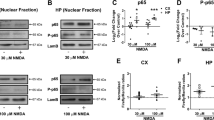We studied the effect of tetrahydrobiopterin (BH4), one of the co-factors of NO synthase (NOS), on the process of inactivation of this enzyme in a cytoplasmic fraction obtained from rat cerebellar tissue. Tetrahydrobiopterin stimulated in a dose-dependent manner the activity of NOS measured according to accumulation of [3H]-citrulline. In the course of reaction at 37°С without the addition of BH4, the enzymatic activity rapidly decreased; in the presence of 10 μM BH4, the rate of inactivation of NOS was noticeably smaller. Preincubation (40 min long) under the same conditions but in the absence of substrates (arginine and NADPH) and BH4 also led to a decrease in the enzymatic activity. Preincubation in the presence of 1 mM BH4 not only slowed down inactivation of NOS but also provided an appreciable increase in its activity, as compared with the variant without preincubation. This fact is indicative of the presence of a BH4-free inactive form of the above-mentioned enzyme in the cytoplasmic fraction, which can be additionally activated. The obtained data show that BH4 stabilizes the activity of NOS due to a decrease in the rate of inactivation of this enzyme occurring independently of realization of the enzymatic reaction.
Similar content being viewed by others
References
J. F. Kerwin, Jr., J. R. Lancaster, Jr., and P. L. Feldman, “Nitric oxide: a new paradigm for second messengers,” J. Med. Chem., 38, No. 22, 4343–4662 (1995).
D. J. Stuehr, “Structure-function aspects in the nitric oxide synthases,” Annu. Rev. Pharmacol. Toxicol., 37, 339–359 (1997).
A. C. Gorren and B. Mayer, “Tetrahydrobiopterin in nitric oxide synthesis: a novel biological role for pteridines,” Curr. Drug Metab., 3, No. 2, 133–157 (2002).
D. Papale, C. Bruckmann, B. Gazur, et al., “Oxygen activation in neuronal NO synthase: resolving the consecutive mono-oxygenation steps,” Biochem. J., 443, No. 2, 505–514 (2012).
J. M. Griscavage, J. M. Fukuto, Y. Komori, and L. J. Ignarro, “Nitric oxide inhibits neuronal nitric oxide synthase by interacting with the heme prosthetic group. Role of tetrahydrobiopterin in modulating the inhibitory action of nitric oxide,” J. Biol. Chem., 269, No. 34, 21644–21649 (1994).
L. Huang, H. M. Abu-Soud, R. Hille, and D. J. Stuehr, “Nitric oxide-generated P420 nitric oxide synthase: characterization and roles for tetrahydrobiopterin and substrate in protecting against or reversing the P420 conversion,” Biochemistry, 38, No. 6, 1912–1920 (1999).
A. Reif, L. G. Fröhlich, P. Kotsonis, et al.,“Tetrahydrobiopterin inhibits monomerization and is consumed during catalysis in neuronal NO synthase,” J. Biol. Chem., 274, No. 35, 24921–24921 (1999).
C. Gorren, A. Schrammel, K. Schmidt, and B. Mayer, “Thiols and neuronal nitric oxide synthase: complex formation, competitive inhibition, and enzyme stabilization,” Biochemistry, 36, No. 14, 4360–4366 (1997).
E. R. Werner, N. Blau, and B. Thony, “Tetrahydrobiopterin: biochemistry and pathophysiology,” Biochem J., 438, No. 3, 397–414 (2011).
C. X. Luo and D. Y. Zhu, “Research progress on neurobiology of neuronal nitric oxide synthase,” Neurosci. Bull., 27, No. 1, 23–35 (2011).
A. G. Splittgerber and J. Sohl, “Nonlinearity in protein assays by the Coomassie blue dye-binding method,” Anal. Biochem., 179, 198–201 (1989).
D. S. Bredt and S. H. Snyder, “Isolation of nitric oxide synthetase, a calmodulin-requiring enzyme,” Proc. Natl. Acad. Sci. USA, 87, No. 2, 682–685 (1990).
V. I. Bounnik and O. G. Pavlova, “Inactivation of a-ketoglutarate dehydrogenase in the course of enzyme reaction,” Biokhimiya, 62, No. 9, 1137–1147 (1997).
O. M. Poltorak, E. S. Chukhrai, and I. Yu. Torshin, “Dissociative thermoinactivation, stability, and activity of oligomeric enzymes,” Biokhimiya, 63, No. 3, 360–369 (1998).
S. R. Jaffrey and S. H. Snyder, “PIN: an associated protein inhibitor of neuronal nitric oxide synthase,” Science, 274, No. 5288, 774–777 (1996).
J. Dreyer, M. Schleicher, A. Tappe, et al., “Nitric oxide synthase (NOS)-interacting protein interacts with neuronal NOS and regulates its distribution and activity,” J. Neurosci., 24, No. 46, 10454–10465 (2004).
T. Bender, A. M. Silverstein, D. R. Demady, et al., “Neuronal nitric-oxide synthase is regulated by the Hsp90-based chaperone system in vivo,” J. Biol. Chem., 274, No. 3, 1472–1478 (1999).
Author information
Authors and Affiliations
Corresponding author
Rights and permissions
About this article
Cite this article
Tsyvkin, V.N. Stabilizing Action of Tetrahydrobiopterin on the Activity of Neuronal Nitric Oxide Synthase. Neurophysiology 44, 351–355 (2012). https://doi.org/10.1007/s11062-012-9305-x
Received:
Published:
Issue Date:
DOI: https://doi.org/10.1007/s11062-012-9305-x



